Keto Diet Fruit Allowed: The Best Keto Fruit List, Carbs, and Recipes
What are the best fruits for the keto diet? What are the carb counts of keto-friendly fruits? What are some delicious keto fruit recipes?
Foods You Can Eat on the Keto Diet
The ketogenic (keto) diet is a high-fat, very low-carbohydrate, and moderate-protein diet. There are lots of healthy foods you can eat on the keto diet, but it’s important to make sure you get enough fiber. Foods you can eat on the keto diet include fish and seafood, meat and poultry, non-starchy vegetables like bell peppers, broccoli, and zucchini, avocados, berries, nuts and seeds, eggs, high-fat dairy products, olive oil and other oils, and high-cocoa chocolate.
Research suggests that following the keto diet can help you burn fat while making you feel less hungry. However, some of the weight loss you see at the beginning can actually be due to the release of stored water. Very restrictive diets that lead to fast weight loss can be bad for your health and actually make it harder to maintain your weight goals long-term. Research has shown that losing weight quickly can slow down the rate at which your body burns the energy it gets from food.
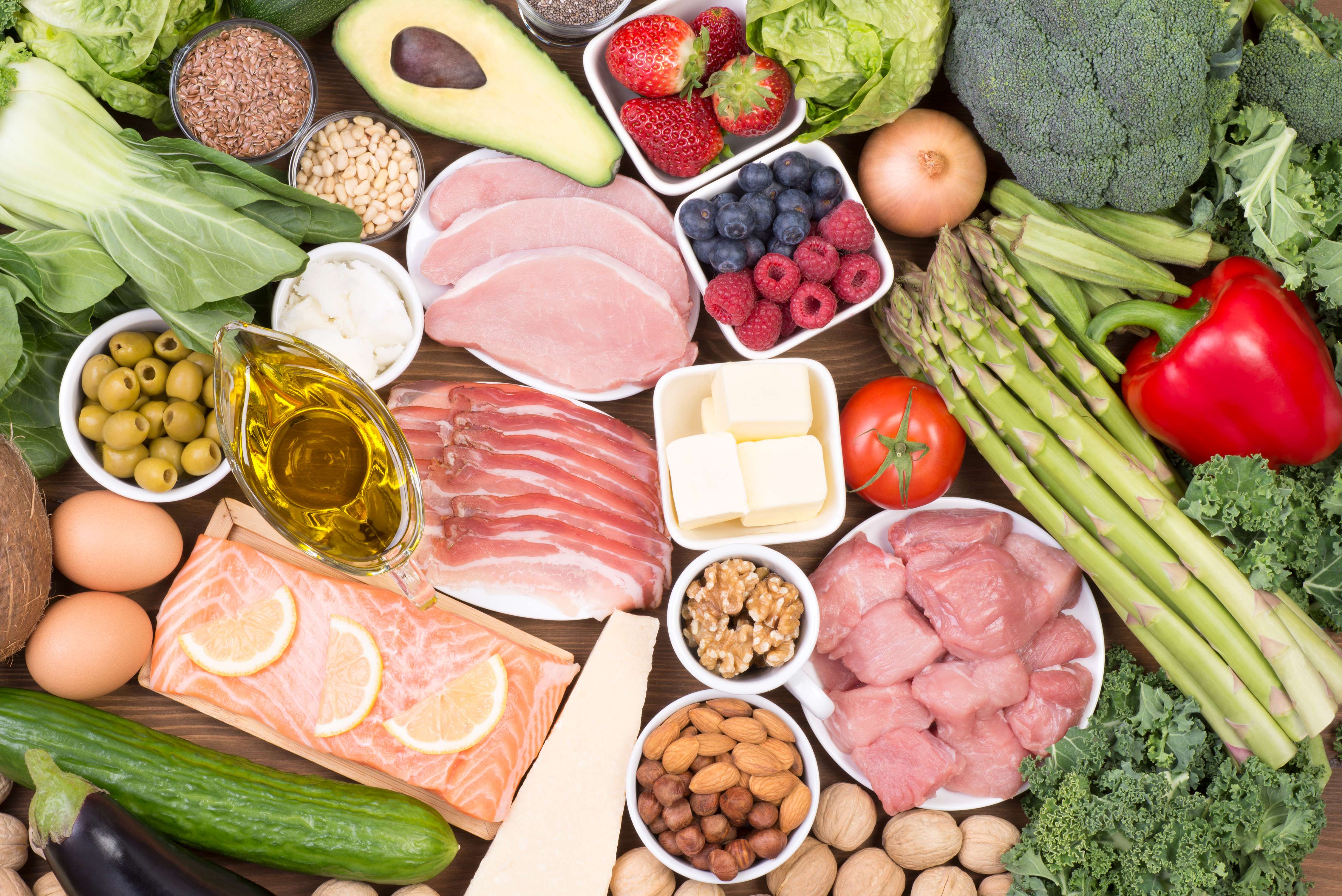
What is the Keto Diet?
The keto diet was originally developed by experts to treat certain types of childhood epilepsy. Doctors may recommend it when other treatments don’t work, and people following a keto diet for epilepsy should do so under careful supervision by a healthcare professional. More recently, keto has become popular among people trying to lose weight. People following a standard keto diet generally aim to get 70–80% of their total daily calories from fat, 10–20% from protein, and 5–10% from carbohydrates. For a 2,000-calorie diet, that’s around 25–50 grams of carbohydrate, 150–180 g of fat, and 50–100 g of protein each day.
The keto diet works by getting your body to change the fuel it uses for energy. Normally, carbohydrates from your food are broken down into glucose, which is the body’s main source of energy. But when you eat fewer carbs, your body starts to use fat as energy instead by turning it into substances called ketones. This is called ketogenesis, and it usually begins about 3 to 4 days after you start restricting your carb intake.
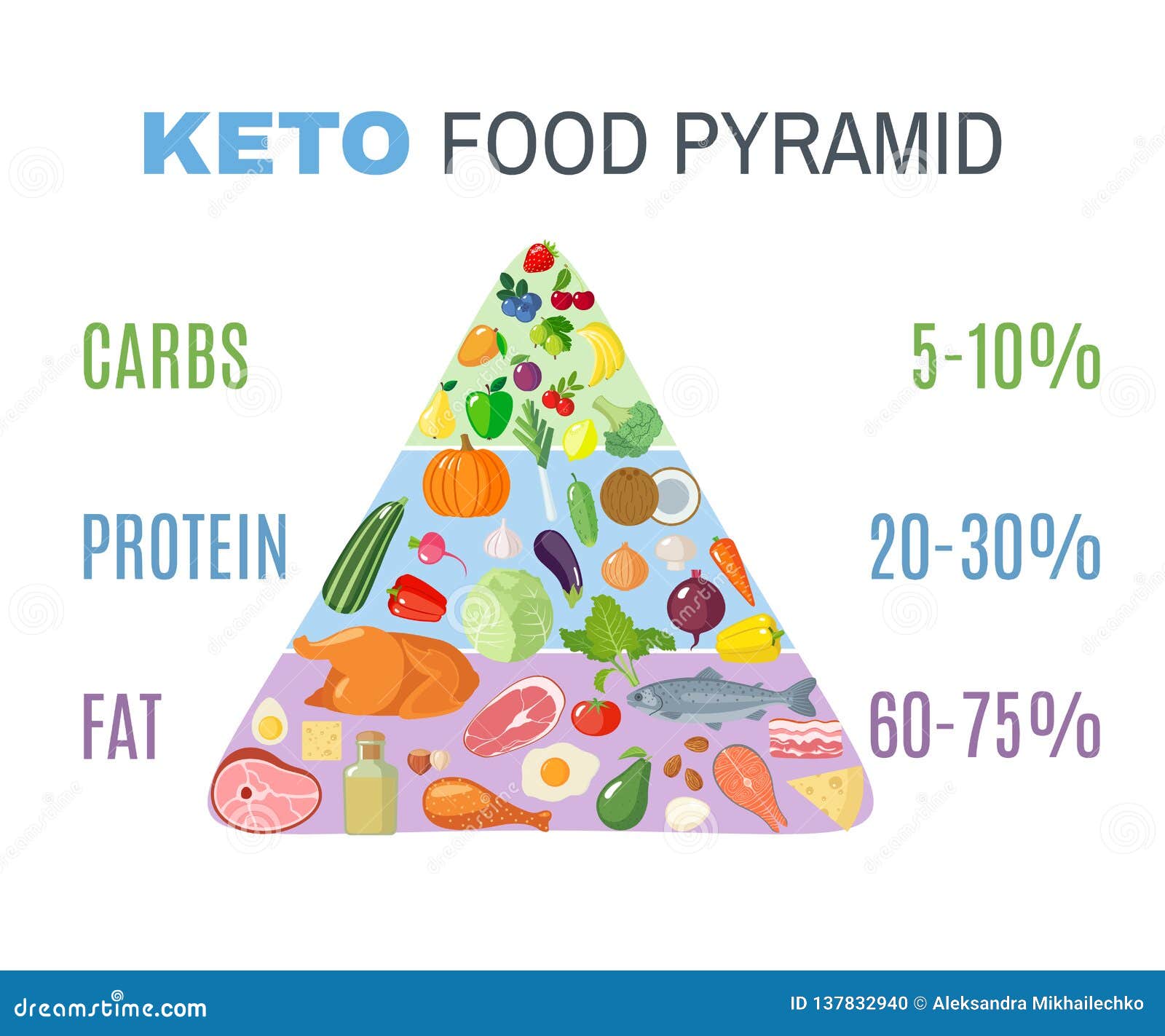
The Importance of Fiber on the Keto Diet
One of the risks of going on the keto diet is that you might not eat enough fiber and B vitamins. That’s because many foods high in fiber and B vitamins — such as whole grains, fruits, vegetables, and legumes like lentils and chickpeas — also contain a significant amount of carbs.
Getting enough fiber in your diet is very important for the health of your gut microbiome, which is the community of trillions of microbes that live in your gut. These microbes digest fiber and turn it into chemicals that are linked to health benefits. As we’ll see below, low-carb plants that still contain a good amount of fiber include non-starchy vegetables like broccoli, cauliflower, and zucchini, as well as avocados, nuts, seeds, and berries.
The fiber in the plants you eat doesn’t count toward your carbohydrate intake because you don’t fully digest it. When people talk about the “net carbs” in a food, they mean the total carbohydrates minus the part that’s fiber.

The Best Keto-Friendly Fruits
While many fruits are too high in carbs to fit into a standard keto diet, there are some low-carb options that can be enjoyed in moderation. The best keto-friendly fruits include:
- Berries (blackberries, raspberries, strawberries, etc.)
- Avocado
- Coconut
- Lemon and lime
- Olives
- Tomatoes
These fruits are low in carbs and high in fiber, vitamins, and other beneficial nutrients. However, it’s still important to monitor your portion sizes and net carb intake when eating them on the keto diet.
Keto-Friendly Fruit Recipes
There are many delicious ways to incorporate keto-friendly fruits into your diet. Here are some recipe ideas:
- Keto Strawberry Shortcake: Made with almond flour and fresh strawberries.
- Avocado Chocolate Mousse: A rich, creamy dessert made with avocado, cocoa powder, and a low-carb sweetener.
- Raspberry Chia Pudding: A nutrient-dense breakfast or snack with chia seeds, raspberries, and coconut milk.
- Lemon Bars: A tangy, low-carb twist on the classic lemon bar made with almond flour and lemon juice.
- Coconut Lime Popsicles: A refreshing, low-sugar treat made with coconut milk, lime juice, and a touch of sweetener.
Conclusion
The keto diet can be a effective way to lose weight and improve health, but it’s important to make sure you’re getting enough fiber and other essential nutrients. By focusing on low-carb, fiber-rich fruits like berries, avocados, and coconut, you can enjoy the benefits of the keto diet while supporting your overall wellbeing.

11 Foods You Can Eat on the Keto Diet
The ketogenic (keto) diet is a high-fat, very low-carbohydrate, and moderate-protein diet. There are lots of healthy foods you can eat on the keto diet, but it’s important to make sure you get enough fiber.
Foods you can eat on the keto diet include fish and seafood, meat and poultry, non-starchy vegetables like bell peppers, broccoli, and zucchini, avocados, berries, nuts and seeds, eggs, high-fat dairy products, olive oil and other oils, and high-cocoa chocolate.
Research suggests that following the keto diet can help you burn fat while making you feel less hungry. However, some of the weight loss you see at the beginning can actually be due to the release of stored water.
Very restrictive diets that lead to fast weight loss can be bad for your health and actually make it harder to maintain your weight goals long-term. Research has shown that losing weight quickly can slow down the rate at which your body burns the energy it gets from food.
At ZOE, we run the largest nutrition and gut microbiome study in the world. Our research shows that if you eat the right foods for your body, your overall health will benefit. Many people on the ZOE program also notice changes to their weight.
Our unpublished research found that people who closely followed their personalized ZOE nutrition programs lost an average of 9.4 pounds after 3 months, while around 80% said they felt less hungry and had more energy.
Before making the decision to switch to a keto diet, you should consider whether you actually need to lose weight.
Obesity increases the risk of health conditions like heart disease, type 2 diabetes, and certain cancers. But if your body mass index (BMI) is in the underweight range or near the bottom of the moderate range, you don’t need to lose weight.
Read on to learn more about the foods you can eat on a keto diet and how to make sure you’re getting enough fiber.
Discover your unique biology
Understand how your body responds to food with ZOE
Take the first step
What is the keto diet?
The keto diet was originally developed by experts to treat certain types of childhood epilepsy. Doctors may recommend it when other treatments don’t work, and people following a keto diet for epilepsy should do so under careful supervision by a healthcare professional.
Doctors may recommend it when other treatments don’t work, and people following a keto diet for epilepsy should do so under careful supervision by a healthcare professional.
More recently, keto has become popular among people trying to lose weight.
People following a standard keto diet generally aim to get 70–80% of their total daily calories from fat, 10–20% from protein, and 5–10% from carbohydrates. For a 2,000-calorie diet, that’s around 25–50 grams of carbohydrate, 150–180 g of fat, and 50–100 g of protein each day.
The keto diet works by getting your body to change the fuel it uses for energy. Normally, carbohydrates from your food are broken down into glucose, which is the body’s main source of energy.
But when you eat fewer carbs, your body starts to use fat as energy instead by turning it into substances called ketones.
This is called ketogenesis, and it usually begins about 3 to 4 days after you start restricting your carb intake.
Foods you can eat on the keto diet
One of the risks of going on the keto diet is that you might not eat enough fiber and B vitamins.
That’s because many foods high in fiber and B vitamins — such as whole grains, fruits, vegetables, and legumes like lentils and chickpeas — also contain a significant amount of carbs.
Getting enough fiber in your diet is very important for the health of your gut microbiome, which is the community of trillions of microbes that live in your gut. These microbes digest fiber and turn it into chemicals that are linked to health benefits.
As we’ll see below, low-carb plants that still contain a good amount of fiber include non-starchy vegetables like broccoli, cauliflower, and zucchini, as well as avocados, nuts, seeds, and berries.
The fiber in the plants you eat doesn’t count toward your carbohydrate intake because you don’t fully digest it. When people talk about the “net carbs” in a food, they mean the total carbohydrates minus the part that’s fiber.
The following is a list of the best healthy food options for a keto diet.
1. Fish and seafood
Fish and shellfish are good choices if you’re following a keto diet.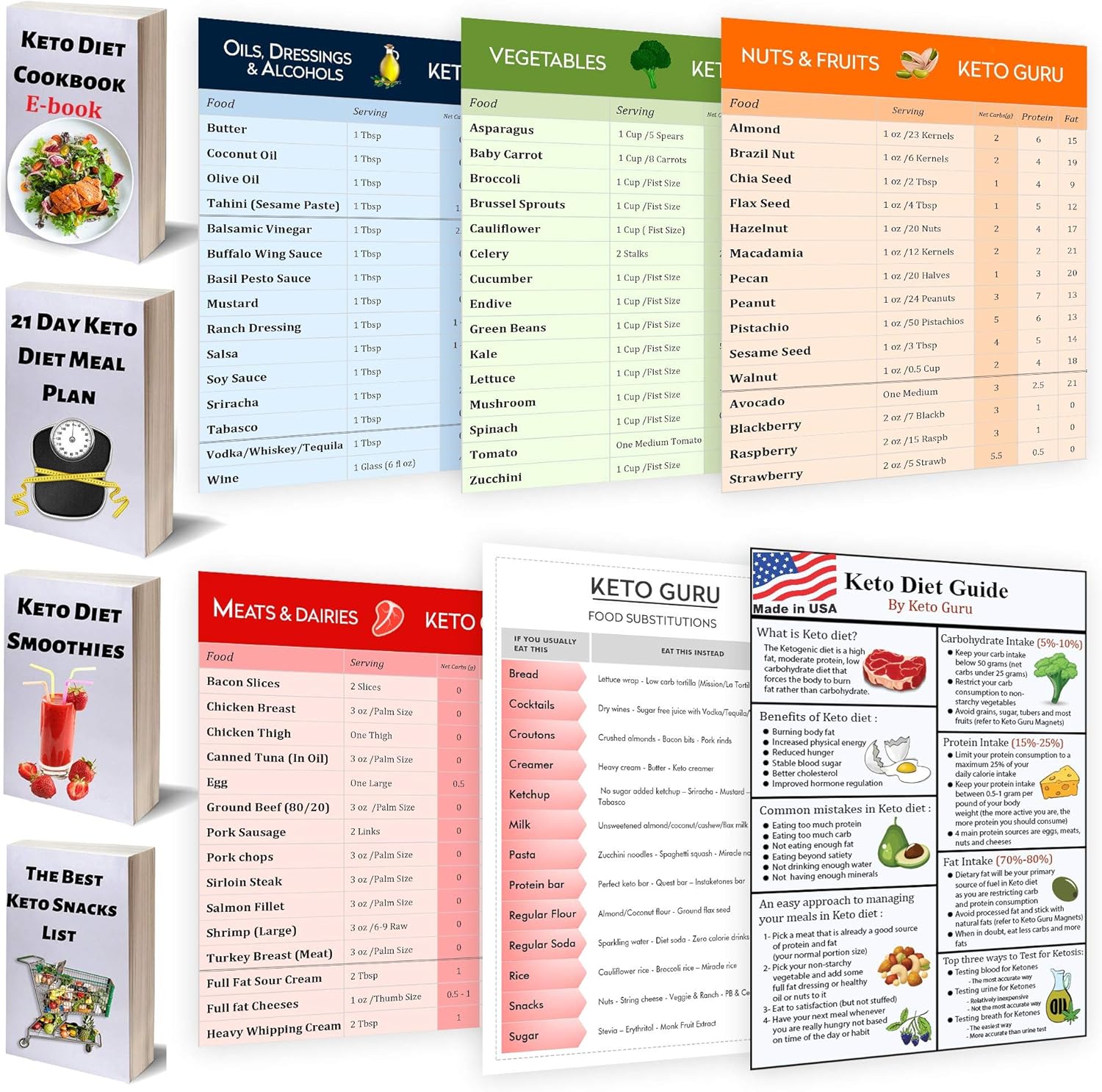 Salmon is high in essential nutrients like omega-3 and B vitamins but very low in carbs. Shrimp and lobster also work well for keto.
Salmon is high in essential nutrients like omega-3 and B vitamins but very low in carbs. Shrimp and lobster also work well for keto.
Macronutrients per 3 ounces (85 g) in fish and seafood:
Salmon: 0 g carbs, 4 g fat, 17 g protein
Flounder: 0 g carbs, 2 g fat, 11 g protein
Crab: 0 g carbs, 1 g fat, 15 g protein
Lobster: 0 g, 1 g fat, 14 g protein
2. Meat and poultry
Meat and poultry are popular with people on the keto diet because they’re high in fat and very low in carbs.
However, scientists have found links between eating too much meat on a regular basis and health conditions like heart disease, type 2 diabetes, and excess weight. That’s why it’s best to eat meat and poultry in moderation.
Macronutrients per 3.5 ounces (100 g) in meat and poultry:
Turkey: 0 g carbs, 12 g fat, 27 g protein
Beef: 0 g carbs, 6 g fat, 123 g protein
Chicken: 0 g carbs, 3 g fat, 32 g protein
Sausages: 2 g carbs, 26 g fat, 18 g protein
3.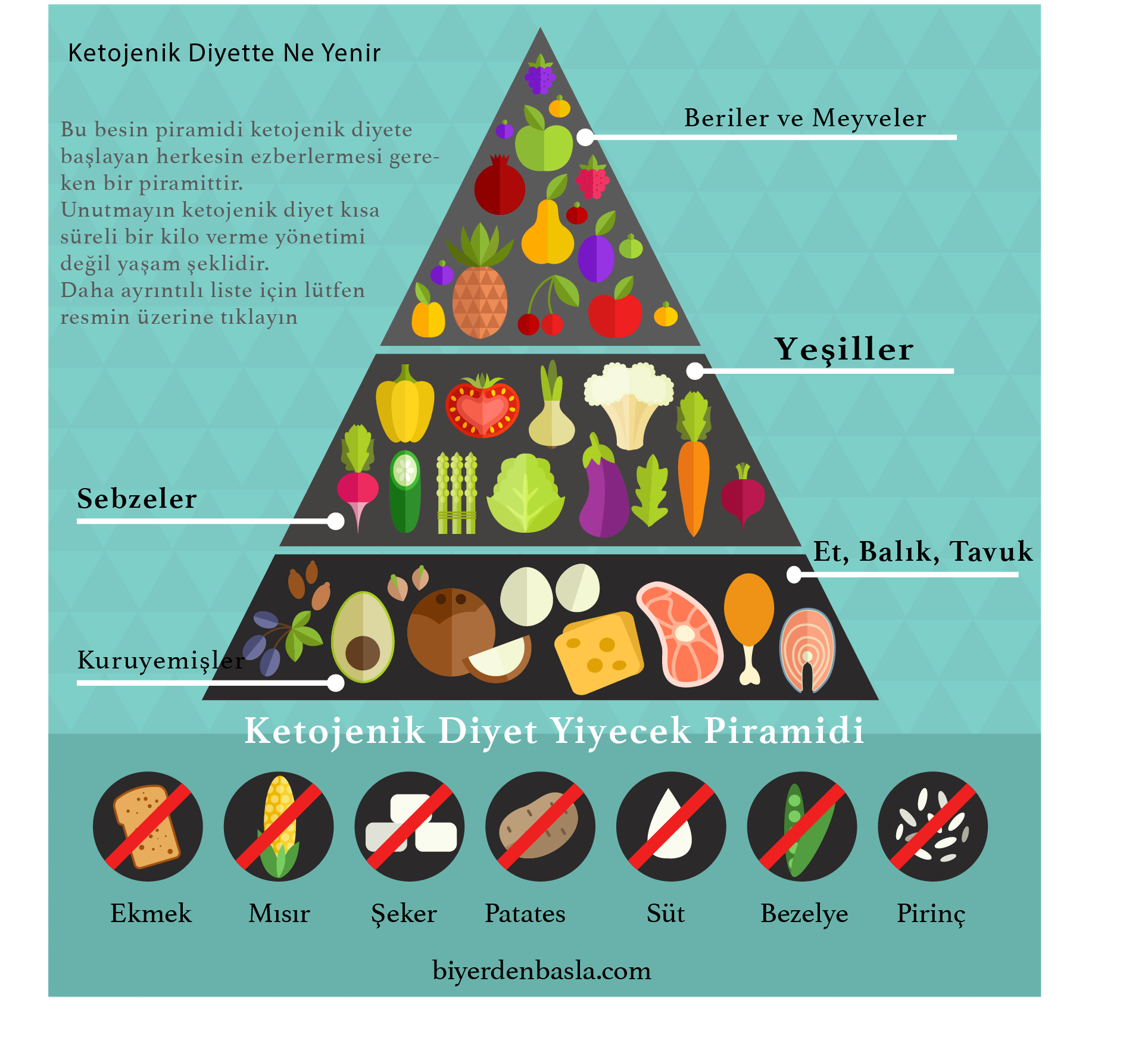 Non-starchy vegetables
Non-starchy vegetables
Vegetables that are low in carbs but still contain fiber are a good option for the keto diet.
They also contain plenty of micronutrients and antioxidants, which are essential for your health.
Non-starchy vegetables can make a great substitute for high-carbohydrate foods. For example, you can use cauliflower to make “rice” and zucchini to make noodles.
Macronutrients per 3.5 ounces (100 g) in low-carb, high-fiber vegetables:
Zucchini: 3 g carbs, 1 g fiber, 0 g fat, 3 g protein
Cauliflower: 4 g carbs, 2 g fiber, 0 g fat, 2 g protein
Bell Peppers: 5 g carbs, 2 g fiber, 0 g fat, 1 g protein
Broccoli: 6 g carbs, 2 g fiber, 0 g fat, 3 g protein
4. Avocados
Avocados are a really popular choice with people following the keto diet since a whole avocado contains only 17 g of carbs — of which 14 g is fiber — and 30 g of fat. They are also high in many vitamins and minerals, including potassium and B vitamins.
Research shows that eating avocados regularly can reduce levels of “bad” cholesterol and improve your heart health.
5. Berries
A lot of fruits are difficult to include in a keto diet because of their high carbohydrate content. But berries are relatively low in carbs and contain healthy antioxidants.
Macronutrients per 3.5 ounces (100 g) in berries:
Strawberries: 8 g carbs, 2 g fiber, 0 g fat, 1 g protein
Blackberries: 10 g carbs, 5 g fiber, 0 g fat, 1 g protein
Raspberries: 12 g carbs, 7 g fiber, 0 g fat, 1 g protein
Blueberries: 15 g carbs, 2 g fiber, 0 g fat, 1 g protein
6. Nuts and seeds
Nuts and seeds are a healthy, high-fat, low-carb food. They also contain plenty of fiber.
Eating nuts has been linked to a lower risk of health conditions including heart disease and diabetes.
Although nuts and seeds are generally low in carbohydrates, there is some variation between different types.
Macronutrients per 1 ounce (28 g) in nuts and seeds:
Pumpkin seeds: 3 g carbs, 2 g fiber, 14 g fat, 9 g protein
Almonds: 6 g carbs, 4 g fiber, 14 g fat, 6 g protein
Cashews: 9 g carbs, 1 g fiber, 12 g fat, 5 g protein
Chia seeds: 12 g carbs, 11 g fiber, 9 g fat, 5 g protein
7. Eggs
Eggs are an easy and affordable source of fat and protein while also being low in carbohydrates, making them a good choice for those following a keto diet.
While previous recommendations warned against eating more than 2 eggs a week, the latest research found that it’s fine for most people to eat 1 egg every day, or 7 eggs in a week.
8. High-fat dairy products
High-fat dairy products are a good source of protein as well as fat.
Some scientists have linked certain dairy products with health benefits. For instance, yogurt can keep you fuller for longer and provides beneficial probiotics for your gut.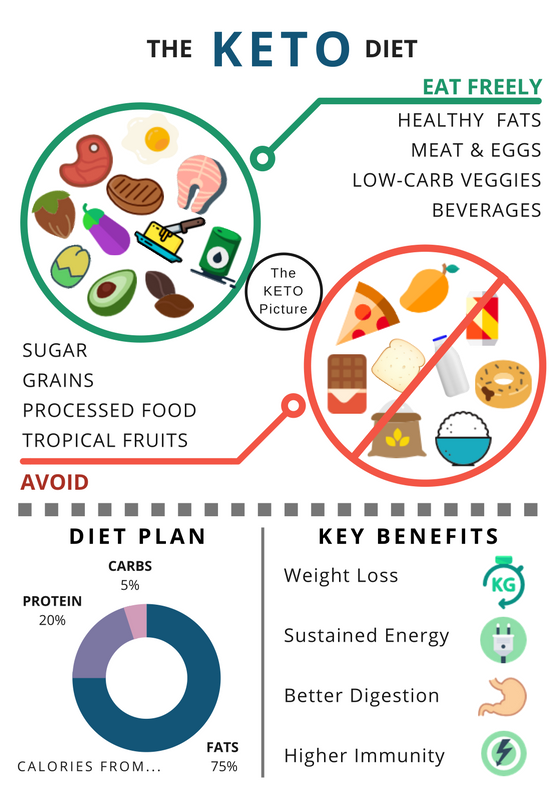
But not everyone agrees. A recent study found that people who substituted carbs with animal products were more likely to die during the 25-year follow up than those who substituted plant-based options like nuts.
It might be a good idea to balance your dairy intake with plant foods while you are on the keto diet.
9. Oil
Some oils are a healthy source of fat and contain no carbohydrates. These include olive, avocado, canola, nut, and seed oils, like flax and hemp oil.
Research has shown that olive oil can protect against heart disease and certain cancers. Both olives and olive oil are a good choice for the keto diet, as they have the same health benefits and have almost no carbs.
Some oils, like avocado, sunflower, and rice bran oil, are more stable when cooking at a high heat.
10. High-cocoa chocolate
Chocolate with a high cocoa content is a good source of antioxidants, including flavanols. Research suggests that it can improve heart health.
Keto-friendly chocolate should contain 70% cocoa or more. Lower cocoa percentage chocolate has a higher sugar content, which will increase your carbohydrate intake.
A 3.5 ounce portion (100 g) of 70% cocoa chocolate contains 43 g of carbohydrates, 7 g of fiber, 47 g of fat, and 7 g of protein.
11. Coffee and tea without sugar
Tea and coffee are good options for a carb-free drink. Both are linked to a large range of health benefits, including living a longer and healthier life.
These benefits are found for both caffeinated and decaffeinated versions, so if you’re sensitive to caffeine or it’s late in the day, choose a decaf option.
Takeaway
It’s possible to follow a keto diet while still eating healthily, as long as you make sure you get enough fiber by eating plenty of plant foods and stick to moderate amounts of meat and dairy.
Lower carb foods that contain a good amount of fiber include non-starchy vegetables like broccoli, cauliflower, and zucchini, as well as nuts and seeds, avocados, and berries.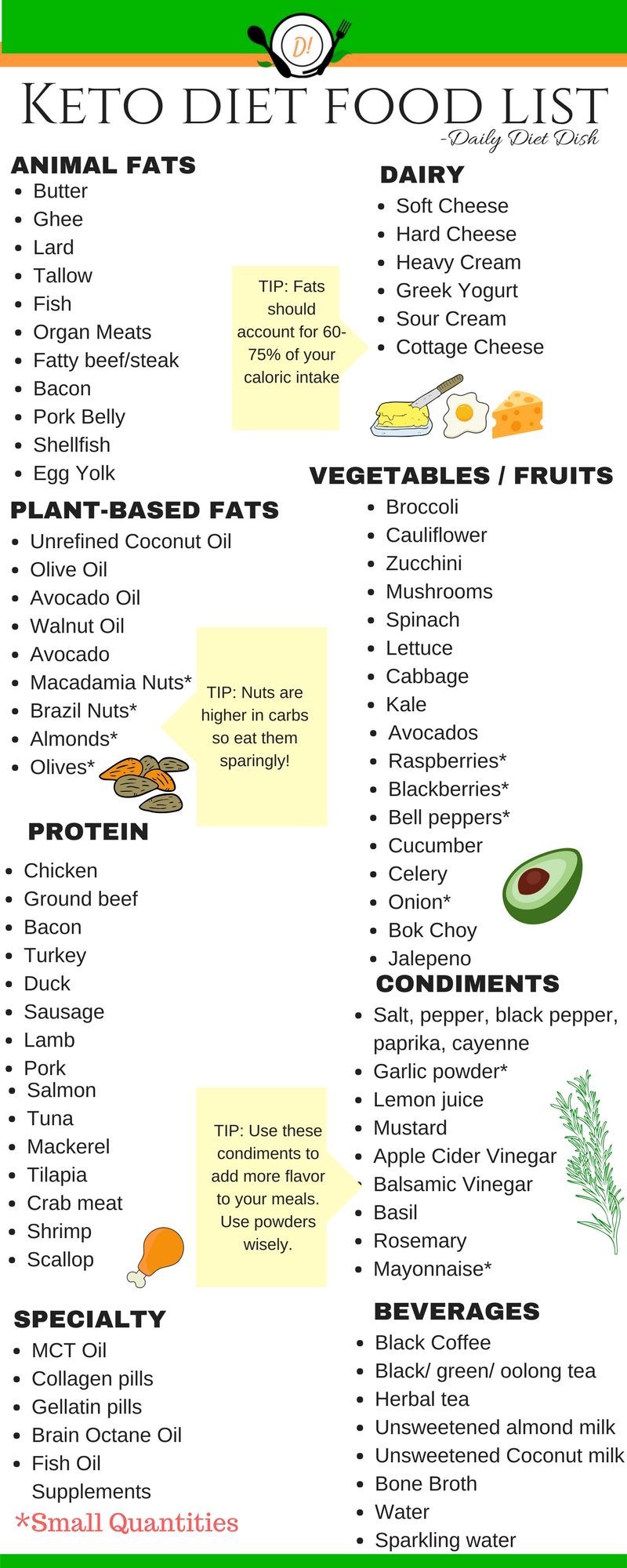
Although the keto diet can lead to weight loss, the data also shows there is no one-size-fits-all approach to food and weight. The keto diet works well for some people, but not so well for others.
Our research at ZOE suggests that many people benefit from including carbohydrates in their diet, and combining these with healthy fats works well for their metabolism.
We also know that some people’s bodies don’t cope well with high amounts of fat in their diet. Eating a lot of fat can put them at risk of dietary inflammation.
Your overall health and weight will benefit if you eat the best foods for your body.
Take our free quiz today to find out how ZOE can help you understand your body’s unique responses to food and how to identify the best foods for your metabolism and weight goals.
Sources
About adult BMI. (n.d.).
https://www.cdc.gov/healthyweight/assessing/bmi/adult_bmi/index.html
Association of coffee drinking with total and cause-specific mortality. The New England Journal of Medicine. (2012).
The New England Journal of Medicine. (2012).
https://www.nejm.org/doi/full/10.1056/NEJMoa1112010
Association of egg intake with blood lipids, cardiovascular disease, and mortality in 177,000 people in 50 countries. The American Journal of Clinical Nutrition. (2020).
https://academic.oup.com/ajcn/article/111/4/795/5713417
Beyond weight loss: a review of the therapeutic uses of very-low-carbohydrate (ketogenic) diets. European Journal of Clinical Nutrition. (2013).
https://www.nature.com/articles/ejcn2013116
Cacao seeds are a “Super Fruit”: A comparative analysis of various fruit powders and products. Chemistry Central Journal. (2011).
https://www.ncbi.nlm.nih.gov/pmc/articles/PMC3038885/
Consumption of nuts and legumes and risk of incident ischemic heart disease, stroke, and diabetes: a systematic review and meta-analysis. The American Journal of Clinical Nutrition. (2014).
https://academic. oup.com/ajcn/article/100/1/278/4576571?login=true
oup.com/ajcn/article/100/1/278/4576571?login=true
Diabetes and cancer: two diseases with obesity as a common risk factor. Diabetes, Obesity and Metabolism. (2013).
https://dom-pubs.onlinelibrary.wiley.com/doi/full/10.1111/dom.12124
Diet Review: Ketogenic Diet for Weight Loss. (n.d.).
https://www.hsph.harvard.edu/nutritionsource/healthy-weight/diet-reviews/ketogenic-diet/
Dietary carbohydrate intake and mortality: A prospective cohort study and meta-analysis. The Lancet. (2018).
https://www.thelancet.com/journals/lanpub/article/PIIS2468-2667(18)30135-X/fulltext
Dietary fiber, gut microbiota, and metabolic regulation – current status in human randomized trials. Nutrients. (2020).
https://www.ncbi.nlm.nih.gov/pmc/articles/PMC7146107/
Effects of chocolate, cocoa, and flavan-3-ols on cardiovascular health: a systematic review and meta-analysis of randomized trials. The American Journal of Clinical Nutrition. (2012).
(2012).
https://academic.oup.com/ajcn/article/95/3/740/4576702?login=true
Effect of a moderate fat diet with and without avocados on lipoprotein particle number, size and subclasses in overweight and obese adults: A randomized, controlled trial. Journal of the American Heart Association. (2015).
https://www.ncbi.nlm.nih.gov/pmc/articles/PMC4330060/
Fiber. (n.d.).
https://www.hsph.harvard.edu/nutritionsource/carbohydrates/fiber/
FoodData Central. (n.d.).
https://fdc.nal.usda.gov/index.html
Impact of yogurt on appetite control, energy balance, and body composition. Nutrition Reviews. (2015).
https://pubmed.ncbi.nlm.nih.gov/26175486/
Ketogenic diet. (2021).
https://www.ncbi.nlm.nih.gov/books/NBK499830/
Ketogenic diet. (n.d.).
https://www.epilepsy.com/learn/treating-seizures-and-epilepsy/dietary-therapies/ketogenic-diet
Ketogenic diet and microbiota: Friends or enemies? Genes. (2019).
https://www.ncbi.nlm.nih.gov/pmc/articles/PMC6678592/
Low Carbohydrate Diet. (2021).
https://www.ncbi.nlm.nih.gov/books/NBK537084/
Meat consumption and prospective weight change in participants of the EPIC-PANACEA study. (2010). The American Journal of Clinical Nutrition.
https://academic.oup.com/ajcn/article/92/2/398/4597346?login=true
Meat consumption and risk of 25 common conditions: outcome wide analyses in 475,000 men and women in the UK Biobank study. BMC Medicine. (2021).
https://bmcmedicine.biomedcentral.com/articles/10.1186/s12916-021-01922-9
Mechanisms linking obesity with cardiovascular disease. Nature. (2006).
https://www.nature.com/articles/nature05487
Nutrients and bioactives in green leafy vegetables and cognitive decline. Neurology. (2018).
https://www.ncbi.nlm.nih.gov/pmc/articles/PMC5772164/
Persistent metabolic adaptation 6 years after “The Biggest Loser” competition. Obesity. (2016).
Obesity. (2016).
https://www.ncbi.nlm.nih.gov/pmc/articles/PMC4989512/
Phenolic compounds isolated from olive oil as nutraceutical tools for the prevention and management of cancer and cardiovascular diseases. International Journal of Molecular Sciences. (2018).
https://www.ncbi.nlm.nih.gov/pmc/articles/PMC6121682/
Tea consumption and mortality of all cancers, CVD and all causes: a meta-analysis of eighteen prospective cohort studies. British Journal of Nutrition. (2015).
https://www.cambridge.org/core/journals/british-journal-of-nutrition/article/tea-consumption-and-mortality-of-all-cancers-cvd-and-all-causes-a-metaanalysis-of-eighteen-prospective-cohort-studies/2D30740B08CD7CD2313BC180B139B9B9
The Impact of Caffeine and Coffee on Human Health. Nutrients. (2019).
https://www.ncbi.nlm.nih.gov/pmc/articles/PMC6413001/
Keto Fruit: 18 Low-Carb Fruits To Enjoy On A Ketogenic Diet
Let’s talk about keto fruit! We’re sharing what we know about keto fruit, low carb fruits, and what we think are the best keto fruits.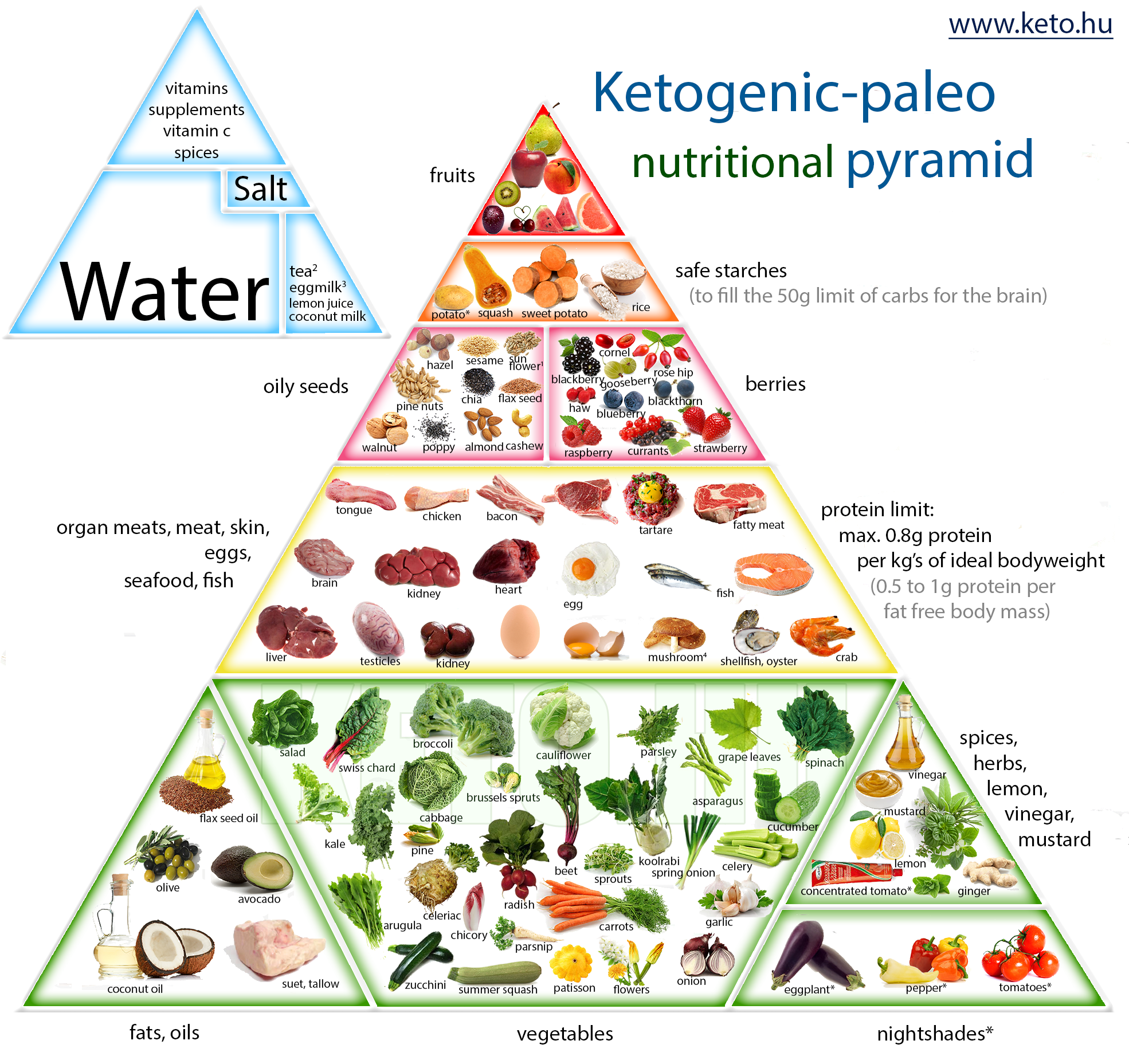
Welcome to Four Score Living where we believe you can achieve and maintain a healthy lifestyle through 80/20 living – and that includes enjoying a select list of keto friendly fruits.
When you think of keto friendly fruit, think avocadoes, berries, tomatoes and olives. They are all high in fiber and low in sugar, making them perfect for a ketogenic diet. That’s the key to low carb fruits – low sugar and high fiber. These keto fruits are rich in antioxidants and also contain many different vitamins, minerals, manganese, potassium and magnesium.
When you are doing a carb load day or in maintenance mode, you can sneak in a few higher carb fruits like peaches, bananas, and pineapple.
For a low carb keto diet, try and stick to keto fruit with less then 5 grams of net carbs as most people aim for no more than 20 grams of net carbs per day on keto. This really helps with weight loss and maintaining blood sugar levels. There are a few on my list that are just over 5.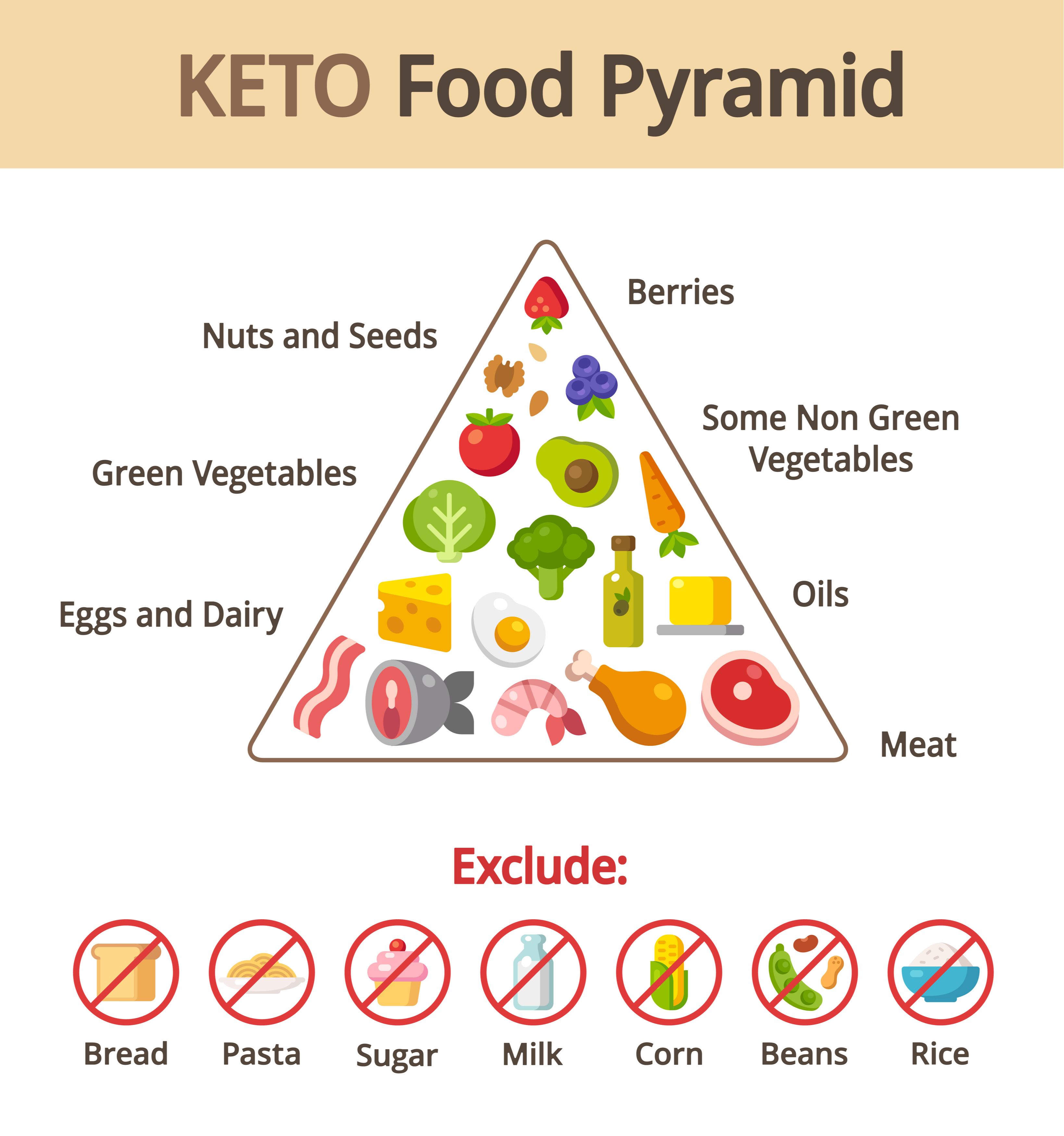 That’s close enough for me.
That’s close enough for me.
KETO FRUIT LIST
Unlike keto vegetables, the list of fruits that are keto friendly is a mix of sweet and savory. The below list includes their net carbs for a ½ cup serving size:
- Avocadoes – 1.8 net carbs for half an Avocado
- Blackberries – 3.1
- Raspberries – 3.3
- Strawberries – 4.1
- Cranberries – 4.6
- Olives – 2.2
- Fresh Coconut – 2.2
- Rhubarb – 1.5
- Tomatoes – 2.4
- Star fruit – 2.5
- Lychee – 1.5 per fruit
- Lemons – 4.2 for a whole lemon
- Lime – 5.1 for a whole lime
- Watermelon – 5.5
- Currants – 5.3
- Guava – 5.8 per fruit
- Cantaloupe – 5.8
- Blueberries – 5.0 for a ¼ cup
FRUIT TO LIMIT DURING KETO
Most fruits are high in sugar and carbs, so that is why they aren’t recommended on keto. Below are some that should be avoided due to their high net carbs. The list includes their net carbs for a ½ cup serving size:
- Apples – 20 for a medium sized apple
- Bananas – 15
- Grapes – 13
- Kiwi – 12
- Mangoes – 11
- Pineapples – 10
- Pears – 8
- Cherries – 8
- Plums – 8
- Papaya – 6.
 5
5 - Peaches – 6.5
BEST LOW CARB FRUITS PLUS KETO RECIPES
Is Avocado keto?
We LOVE avocado with its 1.8 net carbs(8.8 grams of carbs minus its 7 grams of fiber in half of an Avocado). Sliced, mashed, or in easy guacamole, we will find any way we can to include avocado into our meals – topping keto enchiladas or complimenting salmon bites with avocado is a must. It’s super filling and full of heart healthy fats (15 grams in half an Avocado). It adds a creaminess to sauces and dressings. It’s probably our number one most consumed out of all of our favorite keto fruits. Avocados are packed with nutrition, containing vitamins C, E, K, B5, potassium, magnesium, antioxidants, and monounsaturated fats. A medium-sized avocado contains 14 grams of fiber, which is three times as much as a medium-sized apple at 4.5 grams.
Are Tomatoes keto friendly?
Tomatoes are the most popular home garden crop, grown by over 80% of people with a garden in their yard. Guess it’s a good thing that tomatoes are on the approved keto fruit list. Their beautiful red color comes from lycopene, which is linked to many health benefits like improved sun protection, better heart health, and a lower risk of certain types of cancer. Such a versatile fruit, it can be used fresh and made into a delicious keto salsa or as a topping on our keto cheeseburger casserole. Use sundried tomatoes to make our famous easy marry me chicken, just be careful who you serve it to as it is said they will propose to you on the spot.
Guess it’s a good thing that tomatoes are on the approved keto fruit list. Their beautiful red color comes from lycopene, which is linked to many health benefits like improved sun protection, better heart health, and a lower risk of certain types of cancer. Such a versatile fruit, it can be used fresh and made into a delicious keto salsa or as a topping on our keto cheeseburger casserole. Use sundried tomatoes to make our famous easy marry me chicken, just be careful who you serve it to as it is said they will propose to you on the spot.
Are Blackberries keto friendly?
Definitely one of the healthiest fruits you can eat, plus they are perfect for a keto diet as they are low in sugar and high in fiber with only 3.1 net carbs. Add a handful to our almond flour crepes for a delicious nutrient-dense breakfast. Blackberries are loaded with:
- Vitamins C – 15 milligrams per ½ cup serving
- Vitamin K – 1 cup serving has over one third of the daily recommended value.

- Fiber – One cup has 8 grams
- Manganese – helps with healthy bone development and immune system support.
- Antioxidants – help fight free radicals, may help reduce brain inflammation.
Are Raspberries keto?
Raspberries are another super food that is great on a keto diet with only 3.3 net carbs. They’re great as a topping on almond flour waffles. Raspberries are truly heart healthy, as this fruit is packed full of:
- Potassium – which is essential to heart function and proven to lower blood pressure.
- Omega 3 – helps prevent stroke and heart disease.
- Fiber – maintain a healthy digestive tract
- Manganese – necessary for healthy bones and skin
- Antioxidants – help delay some types of cell damage
Are Strawberries keto friendly?
Strawberries are a powerhouse of nutrition. With only 4.1 net carbs per ½ cup, they are the perfect addition to our almond flour scones and for pairing with our keto whipped cream. Strawberries contain many antioxidants (like anthocyanins which gives them their bright red color) vitamins and minerals:
Strawberries contain many antioxidants (like anthocyanins which gives them their bright red color) vitamins and minerals:
- Vitamin C – strawberries are an excellent source of vitamin C which is necessary for supporting our immune system.
- Manganese – another berry high in this trace mineral.
- Vitamin B (Folate) – important for cell function and tissue growth
- Potassium – involved in many essential body functions.
Are Blueberries keto?
Yes they are, but you need to be extra careful with the serving size. A ¼ cup of fresh blueberries has 5 grams of net carbs. Please note I said fresh. The serving size of dried blueberries have 22 grams of net carbs. Please see later in the post for more information on dried fruits. Even with the smaller serving size we definitely recommend adding these antioxidant rich berries to your keto approved fruit list. Blueberries may be tiny, but they pack a big punch when it comes to health benefits as they are rich in antioxidants and full of vitamins and minerals:
- Vitamins C – known to support our immune system
- Vitamin K – helps your blood clot properly
- Manganese – promotes bone and muscle strength
- Soluble fiber – helps manage cholesterol
- Antioxidants – key to reducing the impact of oxidative stress
Are Olives keto?
Olives are excellent on a keto diet. Green or black, Kalamata or Picholine, it doesn’t matter which color or type you choose. This is a fruit that packs a punch plus they’re great on a keto diet as they have very low net carb score of 2.2 grams per ½ cup serving plus 4 grams of fat. Eat them straight up or add to our keto chicken salad or keto taco casserole. Olives are:
Green or black, Kalamata or Picholine, it doesn’t matter which color or type you choose. This is a fruit that packs a punch plus they’re great on a keto diet as they have very low net carb score of 2.2 grams per ½ cup serving plus 4 grams of fat. Eat them straight up or add to our keto chicken salad or keto taco casserole. Olives are:
- Anti-inflammatory due to their high polyphenol content
- Rich in antioxidants which may help reduce chronic inflammation
- Oleocanthal – Olives contain this compound which is believed to reduce your Cancer and Cognitive disease risk
Is Coconut keto?
Fresh coconut is great on keto. The only issue for most people is that fresh coconuts may be hard to find unless you live in a tropical climate, such as South Florida where coconuts grow on trees in abundance. Your most common use of coconut on a low carb diet will be with coconut flour as it is low in carbs. We use it in many of our baked goods such as keto rolls and keto cinnamon rolls. We always get asked about other coconut products:
We always get asked about other coconut products:
- Coconut milk is naturally low carb plus high in fat, it is a great replacement for dairy.
- Coconut flakes are also keto friendly as long as they are unsweetened. Every now and then we replace the walnuts in our keto banana bread with them.
- Coconut sugar and coconut water are to be avoided on a ketogenic diet as they are both too high in carbs and sugar.
Coconut contains minerals like iron, magnesium, zinc, copper, manganese and selenium. It has been shown to help improve good cholesterol, support healthy blood pressure and improve skin health.
Is Watermelon keto friendly?
Watermelon is keto friendly. This fruit has been described as a hydration super star, as it is made up of more than 90% water, making it an ideal fruit to enjoy in moderation on a ketogenic diet. The water in fruits and vegetables is the most nutritious water available! Watermelon has 6 grams of total carbs and 0.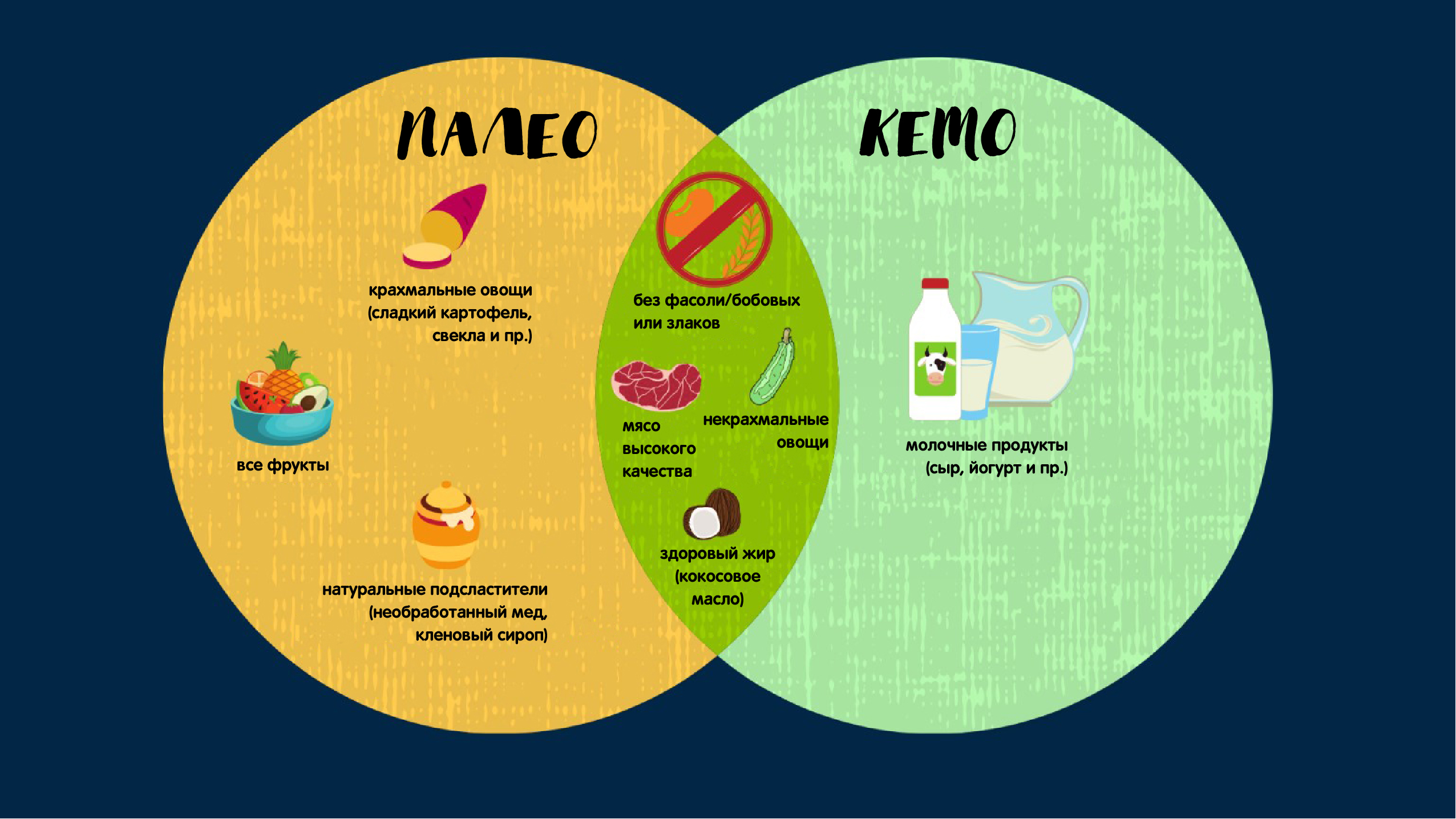 5 grams of fiber in a ½ cup serving, giving it a 5.5 net carb score. Just like tomatoes, watermelon’s red color comes from lycopene which is known to decrease cell damage. It’s also full of vitamin C, potassium and copper.
5 grams of fiber in a ½ cup serving, giving it a 5.5 net carb score. Just like tomatoes, watermelon’s red color comes from lycopene which is known to decrease cell damage. It’s also full of vitamin C, potassium and copper.
Is Star Fruit Keto?
Yes! Star fruit is keto friendly. This tropical fruit, also known as carambola, is a great addition to any keto diet with its 2.5 grams of net carbs in a ½ cup serving. Star fruit adds visual interest to any dish, provides the “yellow” in following the common nutritional recommendation to “eat a rainbow,” and has many health benefits:
- Contains potassium and the trace mineral copper
- Anti-inflammatory properties
- Good source of vitamin C
- Boosts immunity
- Promotes weight loss
- Star fruit has also been known to relieve nausea
Are Cranberries a Keto fruit?
Cranberries are keto friendly when consumed in moderation. Most people think of them at Thanksgiving. Processed, pre-packaged cranberry jelly bought at the store is a big no-no as it’s loaded with sugar. But have no fear, we have a keto cranberry sauce recipe to save the day. Add in our keto stuffing and keto gravy and you are well on your way to a delicious and flavorful meal any time of year! Fresh, natural cranberries are keto approved with their 4.6 grams of net carbs per ½ cup serving. Health benefits of cranberries include:
Processed, pre-packaged cranberry jelly bought at the store is a big no-no as it’s loaded with sugar. But have no fear, we have a keto cranberry sauce recipe to save the day. Add in our keto stuffing and keto gravy and you are well on your way to a delicious and flavorful meal any time of year! Fresh, natural cranberries are keto approved with their 4.6 grams of net carbs per ½ cup serving. Health benefits of cranberries include:
- Powerhouse of antioxidants – help prevent cavities, maintain digestive health, and reduce inflammation
- Vitamins C, E & K
- Manganese
- Strengthen bones and teeth
- Have anti-aging benefits
- Support the bladder and urinary system of the body and thanks to it’s low PH cranberries assist in the prevention of urinary tract infections
Are Lychee keto friendly?
Most people will tell you no, but again as with many fruits, its all about the serving size. Eating three lychees equal 4.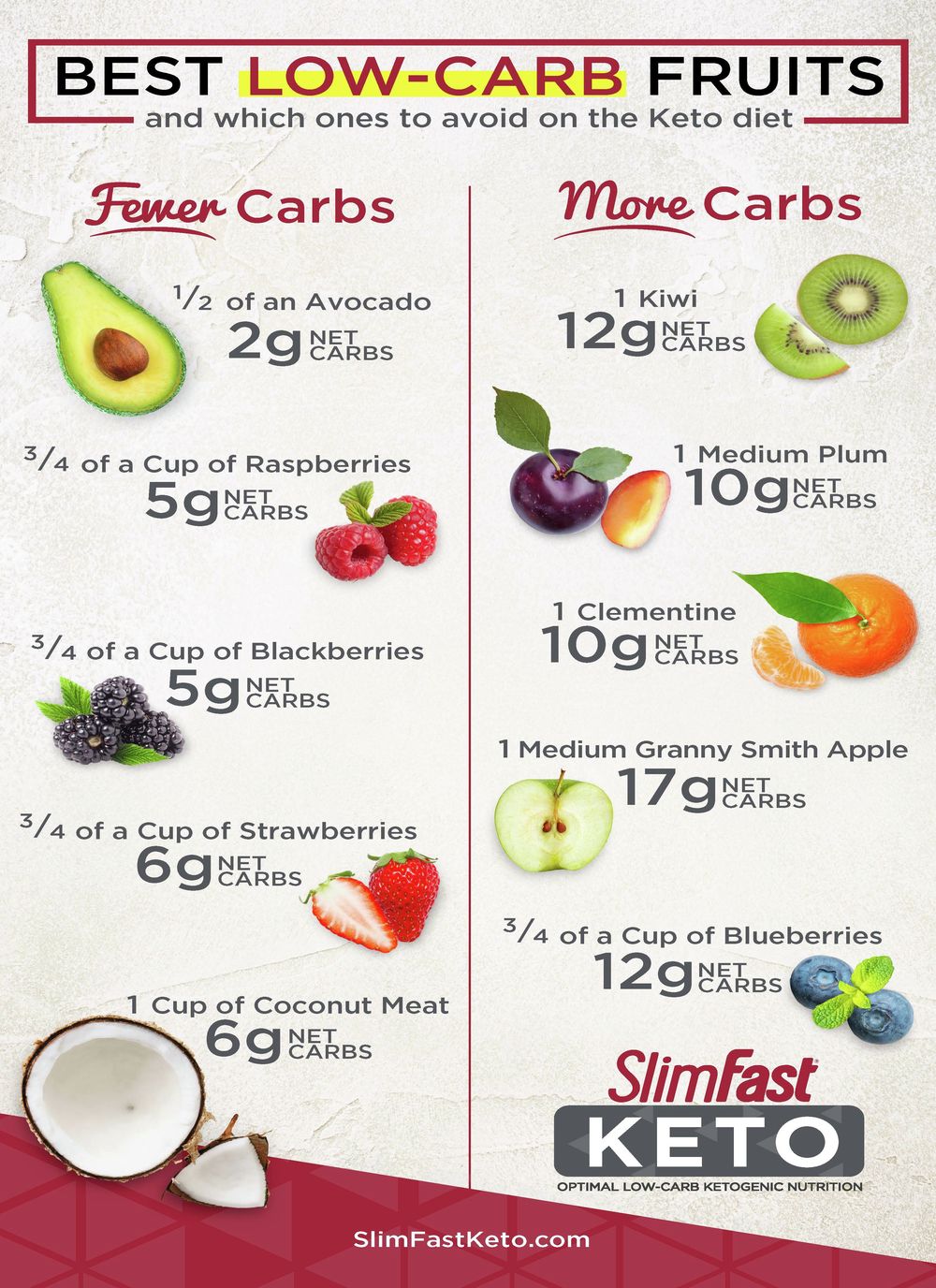 5 grams of net carbs. This fruit can be a refrshing treat on a keto diet and contains:
5 grams of net carbs. This fruit can be a refrshing treat on a keto diet and contains:
- Vitamin C – with one lychee providing 9% of the recommended daily intake.
- Copper – which is very beneficial to heart health
- Potassium – an essential nutrient for heart health
- Antioxidants – like Epicatechin and Rutin
Is dried fruit keto?
Dried fruits are high in calories and carbohydrates. The process of drying, or “dehydrating” the fruit removes the water content, therefore concentrating the sugars. For example, a ½ cup of fresh strawberries is 4.1 net carbs compared to 28 net carbs in only ⅓ of a cup of dried strawberries. Although dried fruits do contain fiber and nutrition, they are best to be avoided when following a keto diet. Fresh fruit, which is high in water content, is the best choice to feel satisfied and maintain hydration with a ketogenic lifestyle.
What about frozen fruit?
Absolutely keto friendly, frozen fruit is a healthy snack on it’s own or to enjoy with meals or desserts.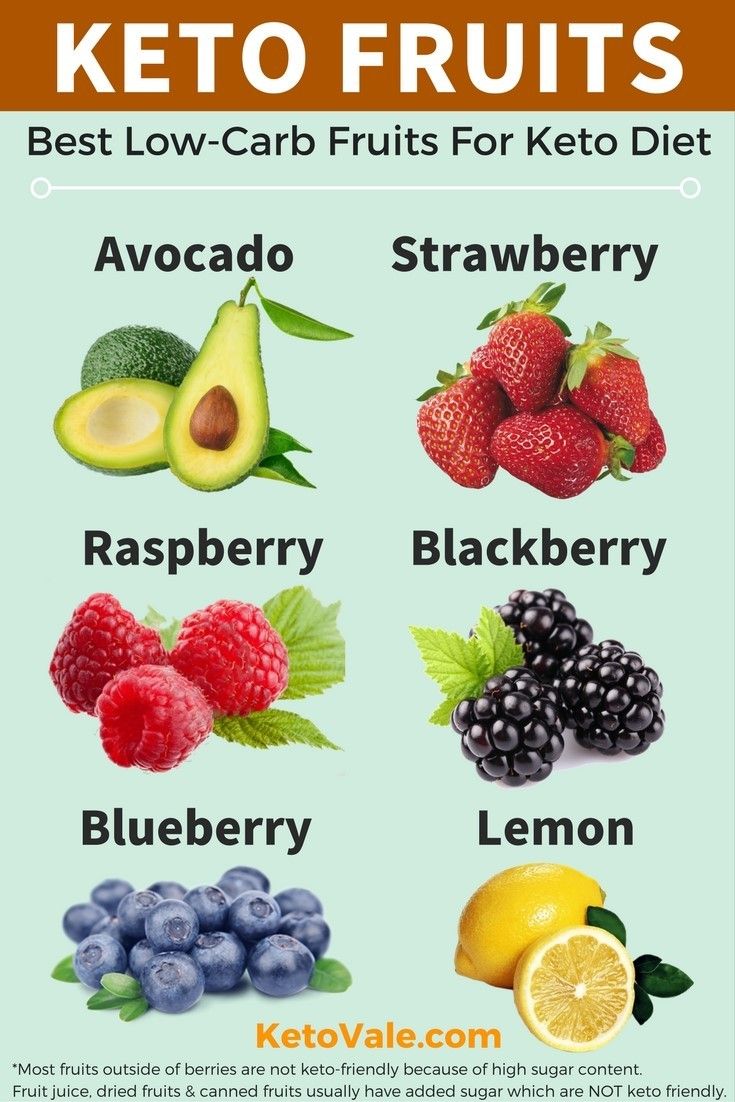 Fruit smoothies, a topping for yogurt or paired with keto baked goods, such as our almond flour blueberry muffins are all options for this easy-to-grab treat. Freezing does not alter nutrients, in fact frozen fruits are packed with higher levels of antioxidants, including lutein, polyphenols, beta-carotene and anthocyanins (the colored pigments in fruits that are antimicrobial and anti-inflammatory). Frozen produce is preservative-free, prewashed and ready to eat which equals no prep time!
Fruit smoothies, a topping for yogurt or paired with keto baked goods, such as our almond flour blueberry muffins are all options for this easy-to-grab treat. Freezing does not alter nutrients, in fact frozen fruits are packed with higher levels of antioxidants, including lutein, polyphenols, beta-carotene and anthocyanins (the colored pigments in fruits that are antimicrobial and anti-inflammatory). Frozen produce is preservative-free, prewashed and ready to eat which equals no prep time!
DON’T WE NEED TO EAT FRUIT TO GET IMPORTANT VITAMINS AND MINERALS?
The short answer is no. You can actually get those same nutrients from vegetables. When most people think of vitamin C, citrus fruits come to mind. There are so many vegetables, like kale, cauliflower, broccoli, and bell peppers, that provide more vitamin C per serving than oranges and grapefruits, plus they have a lot less sugar and carbs. Here is a list of low carb vegetables.
THE BOTTOM LINE
Some people may want to avoid most fruit while on a keto or low carb diet as it can prevent ketosis (a state where your body is burning fat rather than carbs for energy). But as shown above, if you are like me and love fruit, there are many you can still enjoy in moderation. Fresh and frozen keto friendly fruits are packed with fiber, nutrition, and many other health benefits. Whole foods, such as fruit, are certainly a much better option than most pre-packaged foods lining our grocery store shelves.
But as shown above, if you are like me and love fruit, there are many you can still enjoy in moderation. Fresh and frozen keto friendly fruits are packed with fiber, nutrition, and many other health benefits. Whole foods, such as fruit, are certainly a much better option than most pre-packaged foods lining our grocery store shelves.
What’s your favorite recipe using an approved keto fruit? Leave us a comment below letting us know.
More articles you may like:
Keto Vegetables
Keto Smoothie Recipes
Keto Snacks
Keto Breakfast Recipes
Keto Meals
Keto Side Dishes
Keto Desserts
We hope you enjoyed reading this article. Please help us out by leaving a quick review and star ★ rating below.
LET’S GET SOCIAL, you can follow Four Score Living on Pinterest. You can also leave a comment below if you have any questions.
Thanks for sharing!
The Keto Diet: Foods to Eat If You Want to Lose Weight
The Keto Diet is one of the most popular high-fat, low-carb diets that helps the body stay in a constant state of ketosis. It has many advantages and a whole list of allowed and delicious dishes.
It has many advantages and a whole list of allowed and delicious dishes.
The main principle of the keto diet is to maintain a metabolic state in which the body uses fat as a source of daily energy, rather than carbohydrates. This requires eliminating entire food groups, such as carbohydrates and sugar, in order to maintain a state of ketosis. As a general rule, the keto diet usually limits carbohydrate intake to 20-50 grams per day. When you’re just starting out on this diet, restricting entire food groups can be a challenge, but in reality, there are a huge number of foods that can replace forbidden foods.
Animal protein
While cheese, red meat and dairy products are often restricted in other diets, animal protein is the mainstay of the diet on the keto diet. Low-carb cheeses (like feta, cottage cheese, camembert, and cheddar) are just some of the food options that are part of the keto diet along with manchego, mozzarella, halloumi, and brie.
Other animal proteins allowed on the ketogenic diet include:
Seafood – salmon, sardines, mackerel low in carbohydrates and high in omega-3 fats;
Meat and Poultry Fresh produce free of carbohydrates and rich in B vitamins, minerals and protein;
Eggs are an extremely healthy source of protein associated with satiety and good vision;
Cheese;
Greek yogurt;
Butter and cream.

Vegetables
Vegetables are a staple of any diet and an excellent source of nutrients, vitamins, minerals and antioxidants. Dark green leafy vegetables such as kale, spinach, and chard are rich in vitamin K and iron and should be added to main meals without increasing the amount of carbs.
Salad greens, cooking greens, and fresh herbs like thyme, sage, oregano, dill, basil, and lemongrass are all great keto options.
All types of peppers, from small hot jalapeno peppers to bell peppers, can also be safely added to dishes. These flavorful keto vegetables pack a high dose of vitamin C. In fact, one bell pepper can provide 107 percent of your daily intake of this essential vitamin.
Pay attention to other vegetables:
Zucchini, eggplant;
Avocados, olives;
Asparagus, broccoli, cauliflower, green beans, Brussels sprouts;
Cabbage, celery, turnips;
Mushrooms, tomatoes, radishes.

Non-starchy vegetables should be your main source of vitamins on a keto diet. Leafy greens, zucchini, peppers, fatty avocados, and olives are all good alternatives to add to your diet.
Vegetables Not to Eat on a Keto Diet
Although vegetables are included in most diets, there are a few that should be avoided on a keto diet. High-carbohydrate foods such as potatoes and sweet potatoes should not be consumed as this can disrupt the body’s ketogenic state. You should also exclude onions, butternut squash, corn and beets from your diet.
Can I eat fruits on a keto diet?
Most fruits contain too much sugar and carbohydrates to be eaten on a keto diet, but berries, especially strawberries, are the exception.
Blackberries and blueberries are also low carbohydrate foods that are rich in antioxidants, although they should be eaten in moderation on more restrictive diets.
Oils, fats and spreads
Like avocados, olive oil, when consumed in moderation, has a positive effect on the cardiovascular system.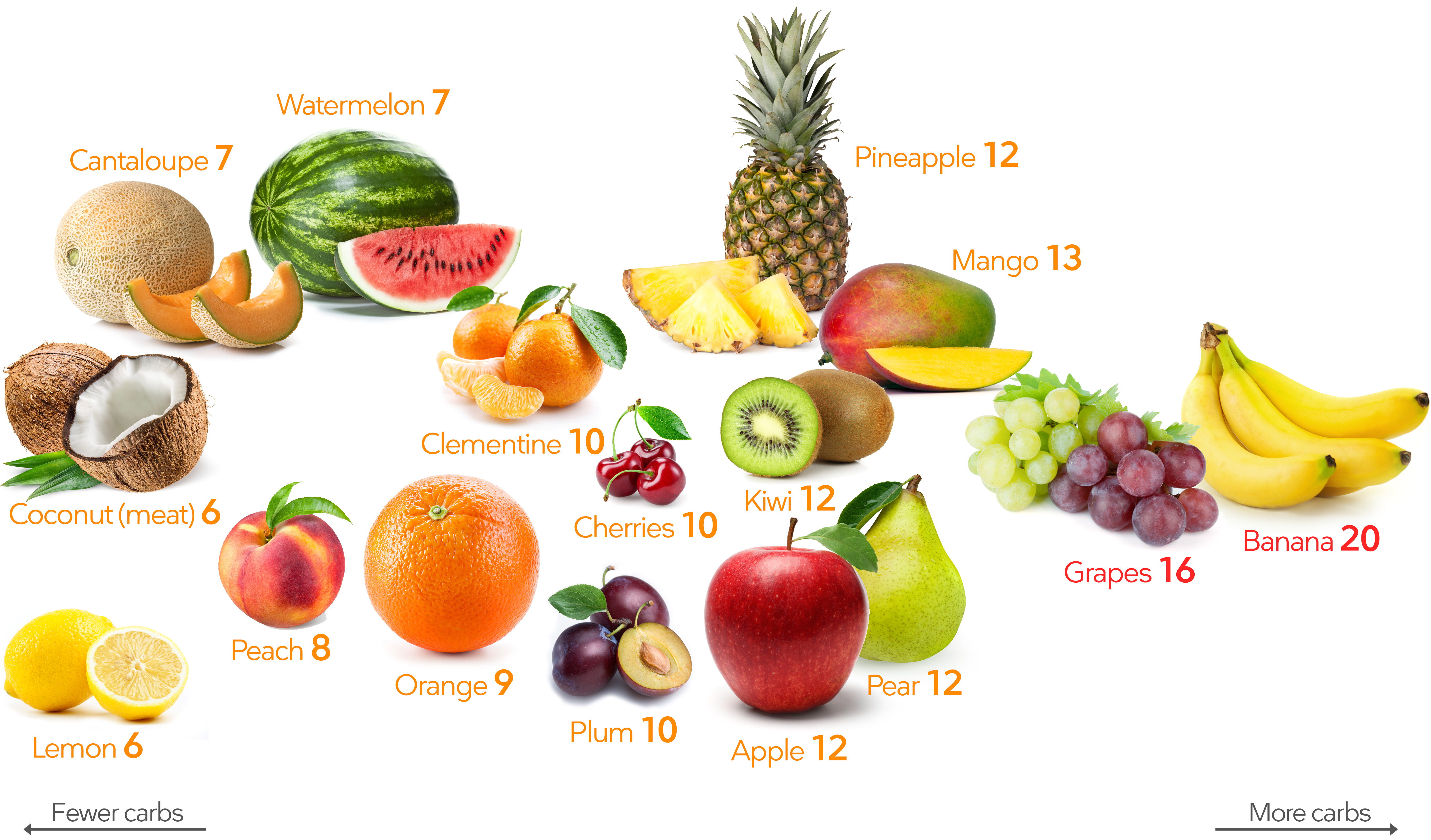 High in oleic acid and antioxidants, the first cold-pressed oil protects the heart by reducing inflammation and the risk of disease.
High in oleic acid and antioxidants, the first cold-pressed oil protects the heart by reducing inflammation and the risk of disease.
Sources of pure fat are the ideal base for salad dressings. Coconut oil, avocado oil, olive oil, and ghee are also not banned, as they meet the requirements of the keto diet – low in carbohydrates and high in fat.
Nuts and sweets
Nuts and pure dark chocolate can be a great snack, which should not be afraid of those who follow a strict diet. Nuts are a good source of fiber, yet they are high in fat and low in carbs. Almonds, macadamia nuts, pecans, walnuts, chia seeds, and flax seeds are great sources of heart-healthy snacks.
Cocoa and dark chocolate are great sources of antioxidants that help fight high blood pressure and keep your arteries healthy ( see also : Nut Spas: 3 Original Nut Recipes).
It is worth noting that only dark chocolate is allowed, which contains at least 70 percent cocoa. Make sure you eat this sweet, low-sugar treat in its purest form.
Photo: Getty Images
Top 10 Keto Foods
If you’ve already decided to go on a keto diet and don’t know what foods to buy to build your plan, this article is for you.
Below is a list (which I compiled from the general recommendations of various nutritionists, from my personal experience and from the literature on the topic) with the main ingredients that will help you create a menu with the right macros.
But first, let’s update a couple of data.
First, be clear that the keto diet is not a high protein diet. It’s also not a low carb diet, it’s essentially a high fat, moderate protein and carbohydrate diet limited to a minimum daily amount.
When carbohydrate intake is reduced, the body turns to stored fat as a new source of fuel: a process called ketosis. To stay in ketosis, you must limit your maximum carbohydrate intake per day to the amount prescribed by your doctor, dietitian, or keto trainer.
Grocery shopping on a keto diet can be a little tricky. Especially when you consider that in America sugar is added to almost everything, and sugar is prohibited in this diet. Many processed and packaged foods are banned precisely because they contain ingredients that can knock you out of ketosis. That is why it is recommended to fill your plate with foods that are low in carbohydrates and high in healthy fats, such as seeds, nuts, meat, seafood, etc.
Fish and seafood
Choose quality proteins such as shellfish and fish high in omega-3 fatty acids: salmon, sardines, mackerel, anchovies, shrimp, crab.
Many studies show that frequent fish consumption is associated with improved mental health and reduced risk of disease.
Seafood is also extremely healthy as it is an excellent source of zinc, copper and vitamin B12.
Low carbohydrate vegetables
Low carb vegetables are rich in fiber, vitamins, minerals, antioxidants and are great for adding fat. Some of the favorites are arugula, spinach, eggplant, mushrooms, broccoli, cauliflower, zucchini, bell peppers, fennel, cabbage, celery, Brussels sprouts, kale. With them, many recipes are prepared that replace rice, pasta or mashed potatoes from ordinary dishes.
Some of the favorites are arugula, spinach, eggplant, mushrooms, broccoli, cauliflower, zucchini, bell peppers, fennel, cabbage, celery, Brussels sprouts, kale. With them, many recipes are prepared that replace rice, pasta or mashed potatoes from ordinary dishes.
Low sugar fruits and berries
No fruit allowed due to high fructose content except strawberries, blueberries and berries in general.
In addition to tomatoes, avocados, olives, coconut and lemons, fruits are important in the diet and many people find them the answer when the body is craving something fresh and sweet. Of course, you always need to be on the lookout so as not to exceed the allowed daily allowances.
There are hundreds of types of berries in the world, and they all contain various anthocyanins, which are flavonoids responsible for the characteristic colors of red, blue and purple flowers. These flavonoids also have powerful anti-inflammatory effects.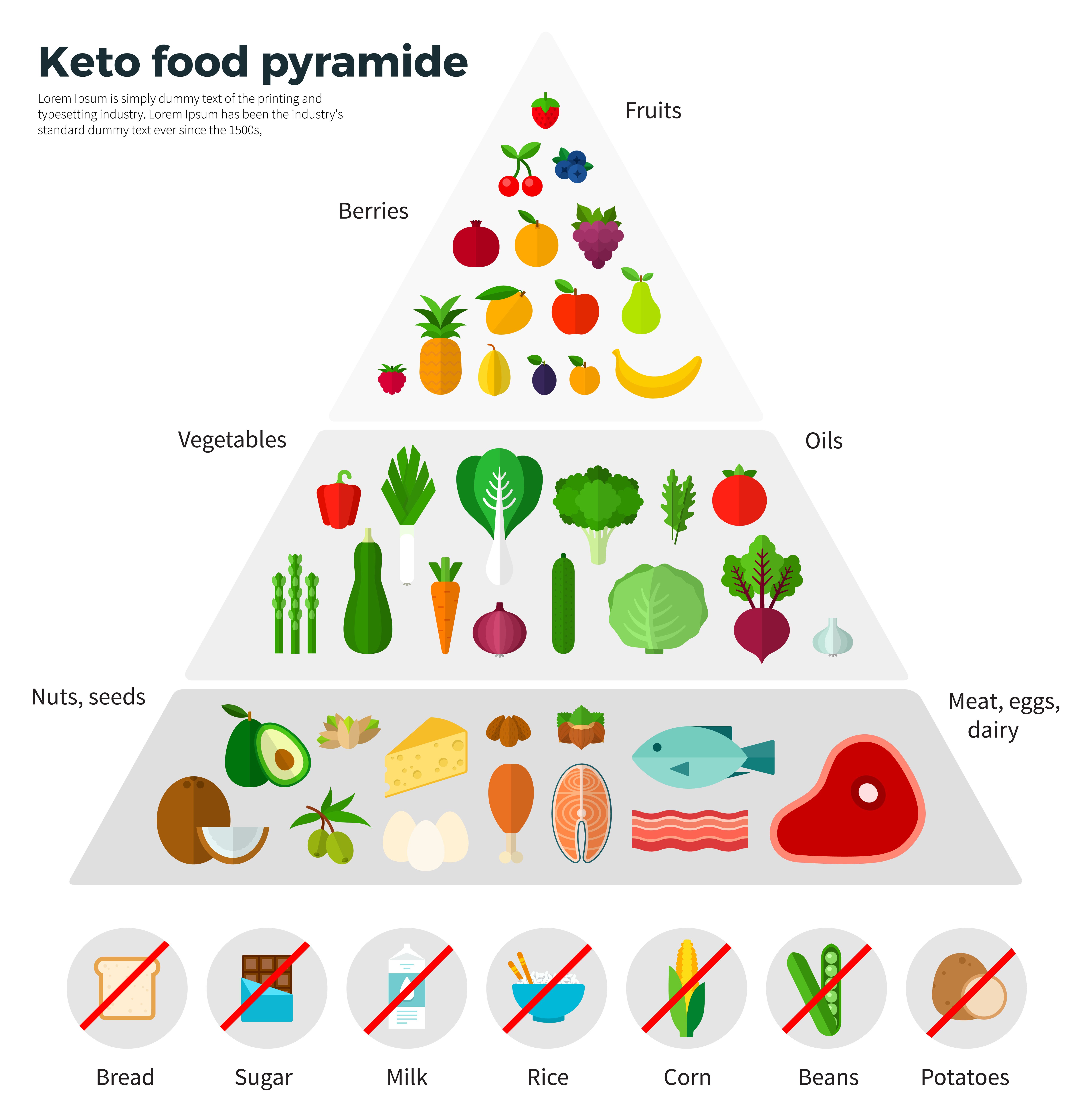
Meat, meat offal and chicken
Meats make up a big part of the keto diet, but experts stress the importance of choosing quality. Buy organic poultry and grass-fed beef whenever possible.
Organ meats are an excellent source of vitamins and minerals. The liver, for example, has retinol, zinc, iron, vitamin B12, and more.
Nuts and seeds
Nuts and seeds are your best friends; they’re high in protein to keep you full longer between meals, and they’re also high in healthy fats.
Also, nut flours are a must for the vast majority of keto dessert recipes. Download the bread recipe here.
Some of the most recommended: Macadamia nuts, flax seeds, Brazil nuts, chia seeds, walnuts, pecans, hemp seeds, hazelnuts, sesame seeds, pumpkin seeds, almonds.
Dairy
Dairy products are a good source of healthy fats, proteins and calcium. And they are often used in the ketogenic diet. Who doesn’t love cheese? It is important to clarify that milk is not allowed, but cream is. And butter also.
And they are often used in the ketogenic diet. Who doesn’t love cheese? It is important to clarify that milk is not allowed, but cream is. And butter also.
Coconut and olive oil
El coconut oil This is one of the wonders of nature. It is rich in MCTs (medium chain triglycerides), which can increase ketone production. In addition, it increases the metabolic rate and promotes weight loss and abdominal fat. It is also rich in lauric acid, which has antibacterial and antiviral properties.
Olive oil is another delicacy of the gods that enhances the taste of dishes, helps to improve the quality of any dish, and is also high in oleic acid, a monounsaturated fat that reduces risk factors for heart disease.
- Avocado
It’s certainly a fruit, but it contains only 2 grams of net carbs per serving (100 grams) and is rich in fiber and several nutrients, including potassium. In addition, it may improve markers of heart health. avocados They are tasty, filling and allow you to create many recipes, from ice cream to salad.
avocados They are tasty, filling and allow you to create many recipes, from ice cream to salad.
- Eggs
Like poultry and meat, eggs are another great source of animal protein. They are perfect in absolutely everything. They contain less than 1 gram of carbohydrates each, are rich in several nutrients, and may help protect eye and heart health. It is an economical, versatile and extremely useful product in the kitchen.
- Chocolate
El dark chocolate This is one of those pleasures that makes those who eat it happy. Contains many flavonoids that reduce blood pressure, risk of heart disease and insulin resistance; it contains so many antioxidants that it is also considered a superfruit. Eat chocolate without fear or guilt, and of course, pay attention to the labels to make sure it has no added sugars and minimal carbs per serving. For those who prefer less bitter chocolate, there are options too, but make sure it doesn’t have ingredients that can kick you out of ketosis.

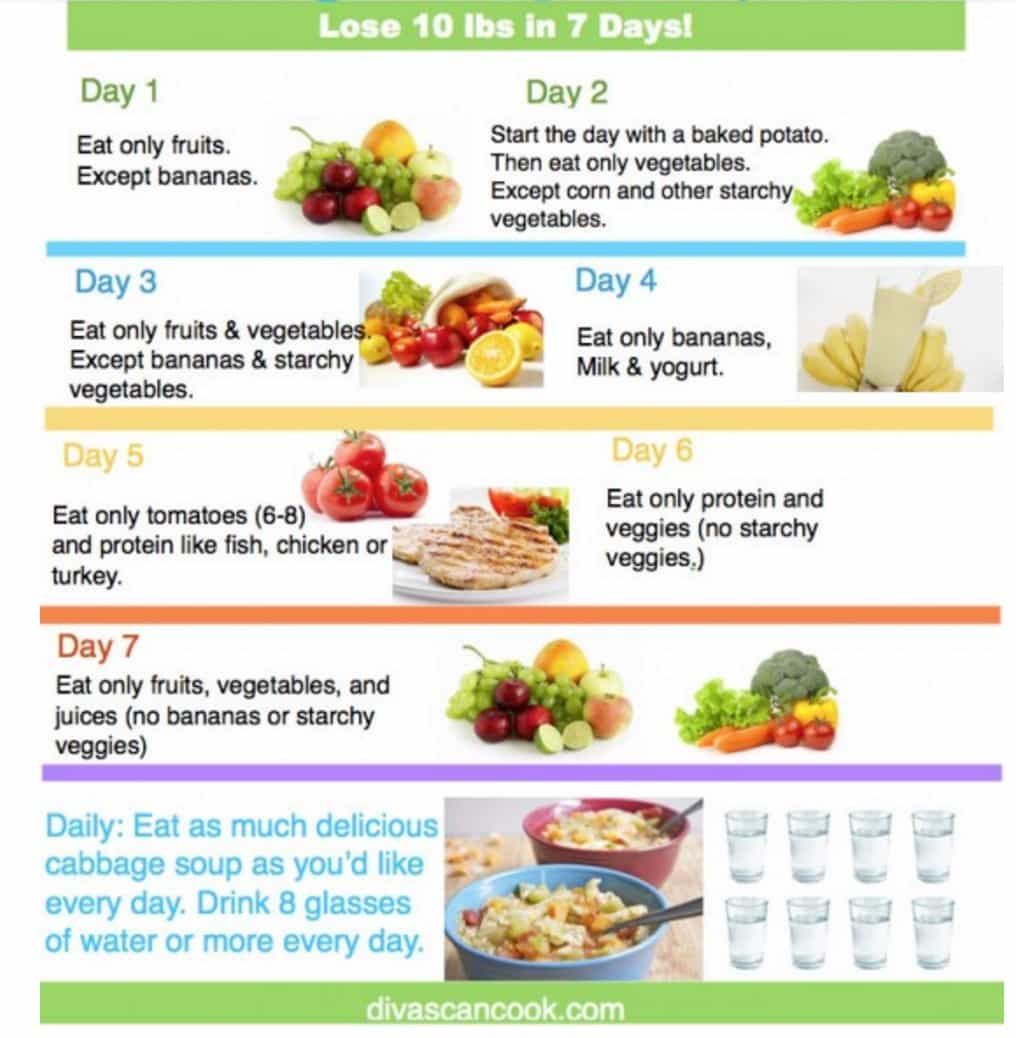 5
5

